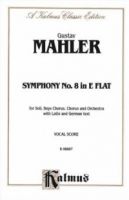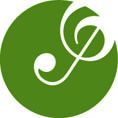Mahler Symphony No. 8 (Symphony of a Thousand) Vocal Score

Vocal Scores for Mahler Symphony No.2
The Symphony No. 8 in E flat major by Gustav Mahler (1860–1911) is one of the grandest choral works in the classical concert repertoire.
The most popular vocal score for Mahler's Symphony No.8 is shown below.
Rehearsal recordings to help learn your voice part (Soprano, Alto, Tenor, Bass) are described below.
Full video version to hear the work in full is also below
.
The Kalmus edition of Mahler's Symphony No.8 is for SATB

Catalogue Number:K06887
ISBN:9780769244822
Please click here if you wish to order and further vocal score information
Please order by 3pm to be despatched today




The Symphony No. 8 in E flat major by Gustav Mahler (1860–1911) is one of the grandest choral works in the classical concert repertoire. Because it requires huge instrumental and vocal forces it is frequently called the "Symphony of a Thousand", although the work is usually performed nowadays with far fewer than a thousand, and Mahler himself did not sanction the name. The work was composed in a single inspired burst, at Maiernigg in southern Austria in the summer of 1906. The last of Mahler's works that was premiered in his lifetime, the symphony was a critical and popular success when he conducted its first performance in Munich on 12 September 1910.
The fusion of song and symphony had been a characteristic of Mahler's early works. In his "middle" compositional period after 1901, a change of direction led him to produce three purely instrumental symphonies. The Eighth, marking the end of the middle period, returns to a combination of orchestra and voice in a symphonic context. The structure of the work is unconventional; instead of the normal framework of several movements, the piece is in two parts. Part I is based on the Latin text of a 9th-century Christian hymn for Pentecost, Veni creator spiritus ("Come, Creator Spirit"), and Part II is a setting of the words from the closing scene of Goethe's Faust. The two parts are unified by a common idea, that of redemption through the power of love, a unity conveyed through shared musical themes.
Mahler had been convinced from the start of the work's significance; in renouncing the pessimism that had marked much of his music, he offered the Eighth as an expression of confidence in the eternal human spirit. In the period following the composer's death, performances were comparatively rare. However, from the mid-20th century onwards the symphony has been heard regularly in concert halls all over the world, and has been recorded many times. While recognising its wide popularity, modern critics have divided opinions on the work; some find its optimism unconvincing, and consider it artistically and musically inferior to Mahler's other symphonies. However, it has also been compared to Beethoven's Ninth Symphony as a defining human statement for its century.
For further information of Mahler's Symphony No.8, please click here to visit the Wikipedia website




ChoraLine 'Voice Part' Rehearsal CDs & EasyPlay (Stream & Download)
Quick and Easy way to memorise your vocal line and practise between choir rehearsals

Know Your Notes Perfectly
Enhance Your Enjoyment when Singing
Learn With The Music
Shine In Your Choir
Sing With Confidence
Please click here to hear a ChoraLine sample for Symphony No.8








